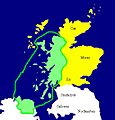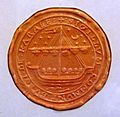History of local government in Scotland facts for kids
The History of local government in Scotland is a complex tale of largely ancient and long established Scottish political units being replaced after the mid 20th century by a frequently changing series of different local government arrangements.
Origins
The history of Scottish local government mainly surrounds the creation and governance of the counties of Scotland. The counties have their origins in the sheriffdoms or shires over which a sheriff (a contraction of shire reeve) exercised jurisdiction. Malcolm III appears to have introduced sheriffs as part of a policy of replacing native "Celtic" forms of government with Anglo Saxon and Norman feudal structures. This was continued by his sons Edgar, Alexander I and in particular David I. David completed the division of the country into sheriffdoms by the conversion of existing thanedoms.
In the later medieval period, government combined traditional kinship based lordships with a relatively small system of royal offices. Until the 15th century the ancient pattern of major lordships survived largely intact, with the addition of two new "scattered earldoms" of Douglas and Crawford, thanks to royal patronage after the Wars of Independence, mainly in the borders and south-west. The dominant kindred were the Stewarts, who came to control many of the earldoms. Their acquisition of the crown, and a series of internal conflicts and confiscations, meant that by around the 1460s the monarchy had transformed its position within the realm, gaining control of most of the "provincial" earldoms and lordships. Rather than running semi-independent lordships, the major magnates now had scattered estates and occasional regions of major influence. In the lowlands the crown was now able to administer government through the system of sheriffdoms and other appointed officers, rather than semi-independent lordships. In the highlands James II created two new provincial earldoms for his favourites: Argyll for the Campbells and Huntly for the Gordons, which acted as a bulwark against the vast Lordship of the Isles built up by the Macdonalds. James IV largely resolved the Macdonald problem by annexing the estates and titles of John Macdonald II to the crown in 1493 after discovering his plans for an alliance with the English.
From the sixteenth century, the central government became increasingly involved in local affairs. The feud was limited and regulated, local taxation became much more intrusive and from 1607 regular, local commissions of Justices of the Peace on the English model were established to deal with petty crimes and infractions. Greater control was exerted over the lawless Borders through a joint commission with the English set up in 1587. James VI was much more hostile to the culture and particularism of the Highlands than his predecessors. He sent colonists from Fife to parts of the region and forced the Highland chiefs to accept Lowland language and culture through the Statutes of Iona 1609. From the seventeenth century the function of shires expanded from judicial functions into wider local administration.
In 1667 Commissioners of Supply were appointed in each sheriffdom or shire to collect the cess land tax. The parish also became an important unit of local government, pressured by Justices in the early eighteenth century, it became responsible for taking care of the destitute in periods of famine, like that in 1740, in order to prevent the impoverished from taking to the roads and causing general disorder. Behaviour could be regulated through kirk sessions, composed of local church elders, which replaced the church courts of the Middle Ages, and which dealt with moral and religious conduct. The local court baron remained important in regulating minor interpersonal and property offences. They were held at the behest of the local baron when there was a backlog of cases and could appoint birleymen, usually senior tenants, who would resolve disputes and issues. The combination of kirk sessions and courts baron gave considerable power to local lairds to control the behaviour of the populations of their communities.
Modern era
As a result of the dual system of local government, burghs (of which there were various types) often had a high degree of autonomy. In 1858 police forces were established in each county under the Police (Scotland) Act 1857.
In 1890 with the Local Government (Scotland) Act 1889 came into force. It established a uniform system of county councils in Scotland. The county councils assumed may of the powers of existing organisations such as the Commissioners of Supply and County Road Trustees and many of the administrative powers and duties of the Justices of the Peace and parochial boards.
Between 1890 and 1929, there were parish councils and town councils, but with the passing of the Local Government (Scotland) Act 1929, the functions of parish councils were passed to larger district councils and a distinction was made between large burghs (i.e. those with a population of 20,000 or more) and small burghs. The Act also created two joint county councils covering Perthshire and Kinross-shire, and Morayshire and Nairnshire, but retained residual Nairnshire and Kinross-shire county councils.
This system was further refined by the passing of the Local Government (Scotland) Act 1947 which created a whole new set of administrative areas known as 'counties', 'counties of cities', 'large burghs' and 'small burghs'. These were to last until 1975.
A Royal Commission on Local Government in Scotland in 1969 (the Wheatley Report) recommended that the interests of local government would best be served by large Regional councils instead of councils based on small counties. The report was largely implemented by the Local Government (Scotland) Act 1973 — creating a system of regions and districts in 1975.
The system was only to last for 21 years as with the passing of the Local Government etc. (Scotland) Act 1994 the regions and districts were re-organised into all-purpose unitary council areas.
Images for kids
-
Map of Scotland, c. 580–600. Pictish regions are marked in yellow. Cumbrian regions in white. Gaelic regions in green.





